Little Yellow-Orange Underwings: Wingspans: 35-45mm
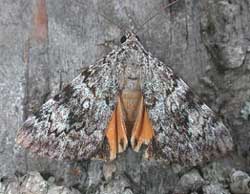
| **8878 TONHS/WO??
Catocala amica;
Girlfriend; 35-40mm.
The black postmedian band is absent from the dorsal (upper)
surface of the hindwing, but it is present on the ventral surface.
Moths come in to lights and to bait.
Catocala amica lineella is sometimes treated as a subspecies;
sometimes as a distinct species.
John Himmelman image.
|
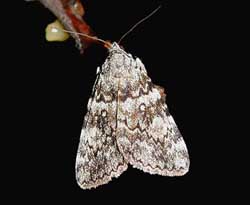
| ** 8878.1 /WO?? lineella;
Little Lined Underwing; 35-40mm.
No marginal black band
on hindwing. Fw subreniform spot pale & boldy
outlined with black. Similar light brownish-gray patch in
upper half of median area near pm line, just between
subreniform spot & am line is similarly
coloured light patch paralleling am lne.
Reniform spot dark, less distinct & in generally darker
area. "Curvifascia": diffuse black-brown arc from
mid costa region toward mid outer margin.
|
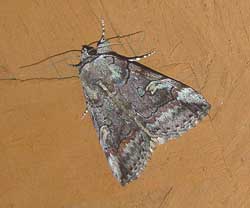
| ** 8873 TONHS/WO?? similis;
Similar Underwing; 35-45mm.
Pale triangular patch from pm line along costa,
pointed at apex, & light-coloured, tear-shaped reniform
spot distinguish this species. Subreniform
spot projects considerably beyond
reniform anteriorally at right angle to line of subreniform.
Many specimens also have small, light coloured, flattened oval spot
about halfway between pm & am lines at about midpoint of
reniform spot. Pm line almost entirely straight.
|
Little Yellow-Orange Underwings: Wingspans: 35-56mm
These tend to be slightly larger on average than preceding group.
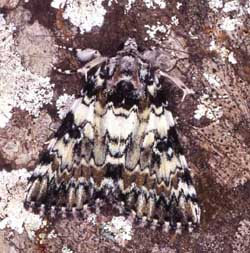
| ** 8877 TONHS/WO?? connubialis,
Connubial Underwing; 35-50mm).
Fw highly variable; several different
forms: "sancta" Hulst: typical form, forewings with
white ground colour & sharply contrasting black lines & markings.
Brown shading between post medial and subterminal
lines; "cordelia" H. Edwards:s coloured as above, markings are
faint; "pulverulenta" Brower: grey-green forewings with faint
markings, sometimes none;
"broweri" Muller: melanic form with fws dark
green, almost black.
Hw has separate anal spot and outer band ends with a
straight cut.
|
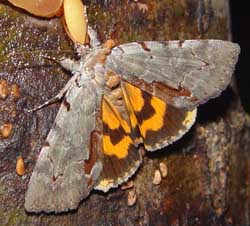
| ** 8864 TONHS/RL Catocala grynea ; Woody Underwing; 40-50mm
The forewing is a dull greenish grey with orangey-brown shading along
the inner margin. The antemedial, median and postmedial lines are
quite faint.
Praeclara is somewhat similar but has a break in the brown shading
between the am and pm lines. Praeclara also has a paler orange
hindwing color.
Tim Dyson image. |
Catocala gryneaa, Hannibal, Oswego County, August 15, 1997, Randy Lyttle.
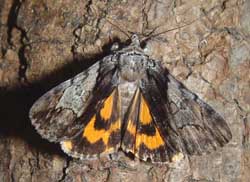
| ** 8858 TONHS/WO?? Catocala crataegi WO;
Hawthorn Underwing; 40-50mm.
Determination is based on dark (black) shading in forewing basal
area continuing along inner margin to anal angle and brown shading
beyond postmedial line. There is also a definite greenish cast to
median area.
The lower wing has the outer black band, broken near the anal angle,
distinguishing crataegi from blandula.
Tim Dyson image.
|
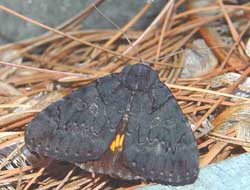
| ** 8775 TONHS/WO?? antinympha;
Sweetfern Underwing; 45-55mm.
The very dark grey, almost black, forewing ground colour
distinguishes antinympha. There is some brown shading in the
subreniform spot and also just outside the postmedial line.
The hindwing is amber to pale orange.
There is also the form multoconspicua Reiff, 1919 with a pale,
almost white subreniform spot.
Tim Dyson image.
|
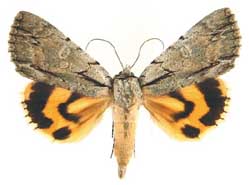
| ** 8772 TONHS/WO?? clintoni;
Clinton's Underwing, wingspan 45-55mm.
The black basal dash distinguishes clintoni from illecta and
abbreviatella, both of which lack the dash.
Vernon Brou image. probably rare if present
|
Catocala sordida 15-Aug-1997
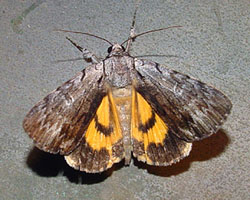
| ** 8772 TONHS/WO?? gracilis;
Graceful Underwing, wingspan 40-45mm.
Gracilis closely resembles sordida but the hindwing loop is not complete in gracilis as it is in sordida. Gracilis also tends to have a darker
inner margin and there is frequently (99% of the time, Dale Schweitzer, via Joe Garris), but not always, a basal dash. Sordida never has the basal dash.
|
|
Midsized Orange-Salmon-Red-Scarlet Underwings: Wingspans: 50-72mm
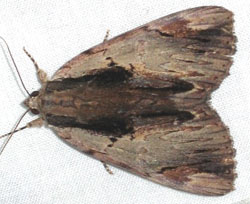
| ** 8857 TONHS/RL Catocala ultronia;
Ultronia Underwing, wingspan: 50-63mm.
The forewings are typically gray-brown, with a distinct and very
dark inner margin and a characteristic light brown patch, underscored
by a very dark arc, near the wingtip.
There can be considerable variation from one specimen to the next.
Underwings can be yellow to orange to salmon.
|
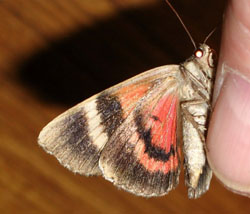
| Catocala ultronia,
the Ultronia Underwing, wingspan: 50-63mm.
There is extensive orange-salmon colouration on the ventral surface
of the hindwings and there is a dark discal lunule.
The ventral surface of the forewings also has a generous suffusion
of orange-salmon scales in the lower half of the median area.
Joe Garris photo.
|
Catocala ultronia, Hannibal, Oswego County, August 15, 1997, Randy Lyttle.
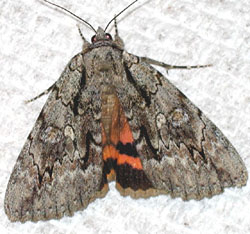
| #8778 TONHS/WO?? Catocala habilis;
55-65mm. Note large "M" on thorax &
"pork chop" shaped, light coloured subreniform spot becoming very
dark in constriction at juncture with pm line. Pm
line narrow, dark & distinct, outwardly lined with
narrow suffusion of white scales, then broader band of brown
scales, then broader suffusion of white scales up to
regular dentation of st line.
"Bleeding" of yellow-orange to salmon scales into
hw fringes.
Large reniform spot has brown center, faintly edged with black,
white, black again.
|
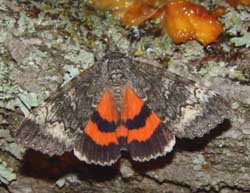
| #8817 TONHS/WO?? briseis;
Briseis Underwing;
60-70mm.
Fws predominantly mottled dark-grey-brown with some lighter areas 1) between pm & st lines, 2) at base of am & pm lines
along im, & 3) over subreniform spot running diagonally toward costa.
Pm lines without greatly elongated & sharly pointed "teeth" near apex.
Hw fringe white & unbroken & inner black band (fairly even) reaches inner margin.
Tim Dyson image.
|
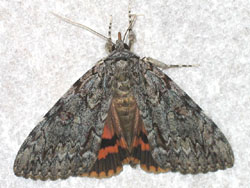
| #8795 TONHS/RL Catocala palaeogama
; 60-70mm.>
Subreniform spot closed, does not approach pm line,
smaller than in C. habilis.
All forms have characteristic orange, heavily barred fringe to
apex, & irregular bands on hws. Hw basal median
area heavily suffused with dark brown to black scales.
Dark bar in outer half of median area,
paralleling inner margin halfway between
inner margin & light, closed subreniform spot.
|
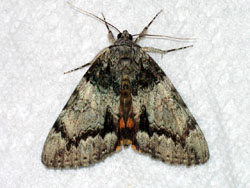
| #8795 TONHS/RL Catocala palaeogama
form phalanga; 60-70mm.
In this form, the forewing basal area and subterminal
area are very dark against a much lighter background.
The dark bar in the outer half of the
median area, paralleling the inner margin halfway between
the inner margin and the light, closed subreniform spot is especially
evident. Joe Garris image.
|
Catocala palaeogama, Hannibal, Oswego County, July 28, 1998, Randy Lyttle.
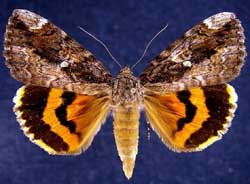
| ** 8770 TONHS/WO??
Catocala innubens;
Betrothed; 55-72mm.
Fw mottled with white, grey & brown,
subrenifrom spot tends to be lighter in colour, although
sometimes obscured by indistinct blackish bar running from
middle of basal/thorax connection to just below much lighter
apex at outer margin.
Jim Vargo image. probably rare if present
|
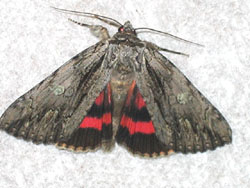
| ** 8851 TONHS/WO??
Catocala coccinata;
Scarlet; 57-70mm.
Usually diffuse basal & anal dashes on otherwise light
grey, mottled forewing.
Hw fringe white (often with some salmon scaling);
heavily checked.
"Tooth" just below pair of elongated "teeth"
much reduced, quite rounded, usually allowing room
for lighter patch of scales. Dark bar across thorax.
Reniform spot light, often with greenish cast. probably rare if present
|
Solid Black Underwings: Smallest to Largest, Similar Species Paired
Most, if not all, of the black underwings range further south where there are more hickory species.
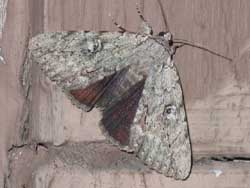
| ** 8781 TONHS/WO??
judith,
Judith's Underwing; 45-55mm.
One of smaller "black" underwings. Fw uniform
light grey with thin and only slightly darkened antemedial, median
and postmedial lines. No darkened dashes (slight anal dash)
or transverse lines. Reniform area slightly darkened while
area just before subterminal line is a bit lighter. Note absence of
hw white fringe.
probably rare if present
|
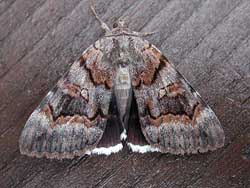
| ** 8773 TONHS/WO??
Catocala epione ;
Epione Underwing, wingspan: 55-65mm
The pm line is squared and has a brown band and then a light band
just outside the line. The hindwing is black with pure white fringe
with no barring.
probably rare if present.
|
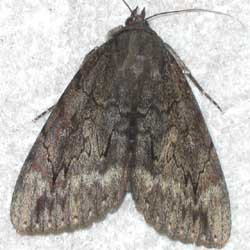
| ** 8785 TONHS/WO??
Catocala residua,
Residua Underwing; 60-73mm.
Distinguished from C. obscura by grey hw
fringe of residua.
Catocala obscura has white to off-white fringe,
less common in northern portions of its range. The forewing
subterminal line/area of Catocala residua tends to be pale as
is its open, elongated subreniform spot.
Like C. obscura it is otherwise devoid of significant markings
except for hint of dark bar running from basal area
through reniform spot to outer margin just below apex. probably rare if present.
|
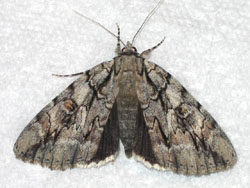
| TONHS/WO??
Catocala retecta;
60-75mm.
Note the light coloured, elongated & open subreniform spot
interrupting dark, diffuse ark running through center of
wing from basal area (body-wing juncture) to forewing
apex. Center of reniform spot is brown, brown
area just below costa running to inner margin just outside pm
line. The off-white hindwing fringe is only lightly checked along
wing veins.
|
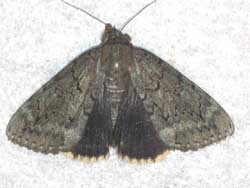
| ** 8784 TONHS/WO??
obscura;
the Obscure Underwing; 60-72mm.
Dull, grey fws, usually void of any significant dashes or
streaks, providing for easy identification. Antemedial, median
& postmedial lines of obscura are faint and subterminal line
region is only slightly paler than rest of fw.
The hindwing fringe is off-white and lightly checked on the veins.
probably rare if present.
|
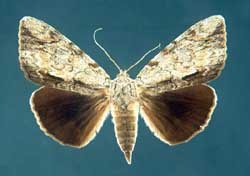
| ** 8791 TONHS/WO??
Catocala insolabilis;
Inconsolable; 65-75mm.
Fw light grey with blackish shading along inner
margin. Antemedial &postmedial lines are thin.
Hw fringe very narrow and grey, becoming whiter toward
apex.
Ventral surface clearly distinguishes insolabis, being almost
completely black except for some white in the basal area.
probably rare if present.
|
|
Large Black Underwings (Banded): Wingspans: 70-80mm
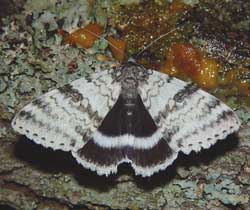
| ** 8803 TONHS/RL Catocala relicta;
Forsaken, White, Relict; 70-80mm.
Considerable variation with regard to black/white
concentrations on fws.
Form clara (depicted), has basal and subterminal
areas predominantly white; form phrynia:
evenly dusted with grey over entire fw.
Typical specimens have the basal and subterminal areas filled with
blackish scales. Black hindwings, with a brilliant even white inner band and
white fringe, are also distinctive. Tim Dyson image.
|
Catocala relicta, Hannibal, Oswego County, August 27, 1998, Randy Lyttle.
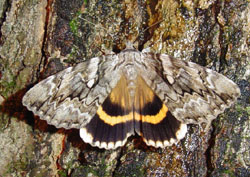
| ** 8802 TONHS/RL Catocala cerogama;
Yellow-Banded; 70-80mm.
Several different forms. The pm line is distinct, dark
and has an elongate pair of projections. The pm and am lines meet inner
margin in relative proximity. Closed subreniform spot
it lighter than surrounding areas, and is shaped a bit like an
arrowhead with point toward body. Hws are
distinctive. Jean-Benoît Duval image. |
|
Catocala cerogama, Hannibal, Oswego County, July 19, 28, 1998, Randy Lyttle.
Large Orange-Salmon Underwings: Wingspans: 65mm, usually 70-95mm
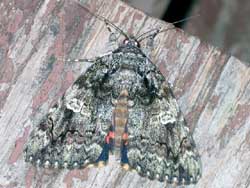
| ** 8801 TONHS/RL
Catocala ilia; Ilia;
65-82mm.
Specimens come in several different forms,
most of them have characteristic white area in and around
reniform spot. Diffuse dark arc running from this
spot to just below outer apex.
Except in worn specimens and darkest forms,
white dots near outer margin of fw are in character
with the overall "contrasting" appearance of this moth.
Joe Garris image.
|
Catocala piatrix, Hannibal, Oswego County, September 11, 1996, Randy Lyttle.
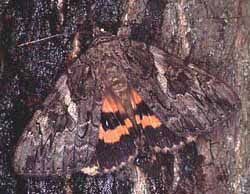
| ** 8771 TONHS/RL Catocala piatrix ;
Penitent, wingspan: 68-84mm
The forewing has a light-colored band/bar extending from the
subreniform spot along the am line to the costa.
The fringe of the hindwing is lightly barred and is lighter in color
than the deeper orange on the rest of wing.
|
Catocala piatrix, Hannibal, Oswego County, September 6, 1998, Randy Lyttle.
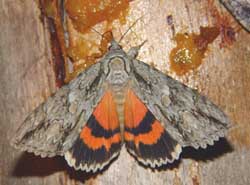
| ** 8806 TONHS/RL Catocala parta;
Mother Underwing; 70-85mm.
The black dashes in the basal, subapical and anal areas help to
identify this species. The hindwings may be yellow to
yellowish-orange but more often are salmon-red. Note the
face-head-like markings on the thorax.
In the hindwing, the first (nearest the apex) black protrusion into
the white fringe is "noticeably" larger than the others.
|
Catocala parta, Hannibal, Oswego County, July 28, 1998, Randy Lyttle.
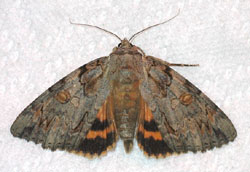
| ** 8798 TONHS/RL Catocala neogama;
70-85mm.
Note brown head, thorax & larger size as compared to
palaeogama. Neogama slightly smaller
than subnata, have darker grey brown fws with more
pronounced markings. Hind tibia examination sometimes needed
for id. Neogama': flattened &
unevenly & sparsely spined; subnata: cylindrical
with spines dense & uniform in distribution.
Joe Garris photo.
|
Catocala neogama, Hannibal, Oswego County, July 29, 1998, Randy Lyttle.
Catocala unijuga 28-Jul-1998
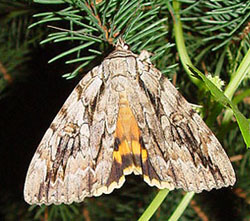
| ** 8797 TONHS/RL Catocala subnata;
Youthful Underwing;: 75-90mm.
Fws greyish white, blue-grey & light brown scales.
subnata usually have hws brighter
yellow than neogama. Neo. usually
have basal dash; absent in male subnata, present in females.
Hind tibia examination distinguishs species:
sub: cylindrical hind tibia;
neo: compressed, flattened hind tibia.
sub: tibia ventral surface densely covered with evenly
distributed spines;
neo: tibia v. surface sparsely covered with sporadic
spines.
|
Catocala subnata, Hannibal, Oswego County, July 29, 1998, Randy Lyttle.
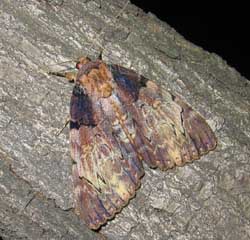
| ** 8796 TONHS/WO?? Catocala nebulosa;
Clouded; 75-86mm.
Moths have prominent dark brown upper-half-basal patch that extends
to and ends at antemedial line. Apical area also tends to be
brown, much darker than median area but not as dark as basal patch.
The anal angle also has the darker brown scaling.
The pm line is distinct near costa and inner margin, but becomes
weak between the two. It meets inner margin in relative close
proximity to am line.
Closed subreniform spot is large and connects to the
pm line via a thin line. probably more southerly
|
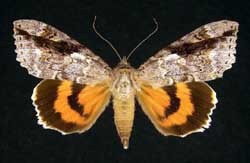
| ** 8804 TONHS/WO?? Catocala marmorata;
Marbled Underwing; 85-95mm;
dark fw arc running from costa down through reniform spot to outer margin just below apex distinguishes this large species from all
other "orange-pinkish-red" underwings.
Subrenifrom spot light, bordered inwardly above by white patch, connected to pm line by a line rather than being open.
endangered ??
|
|
Medium-Large Pink Underwings: Wingspans: 70-95mm
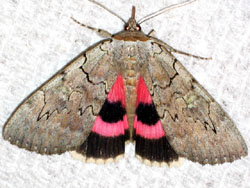
| ** 8833 TONHS/RL concumbens
Sleepy Underwing or
Pink Underwing; 60-75mm.
This brown thoracic collar is quite evident in this image as is the
interruption in the pm line by the open subreniform spot.
The white hindwing fringe is only lightly checked
on the wing veins. The vibrant pink bans are
distinct in colour and also in their relatively smooth contour.
|
Catocala concumbens, Hannibal, Oswego County, September 11, 1998, Randy Lyttle.
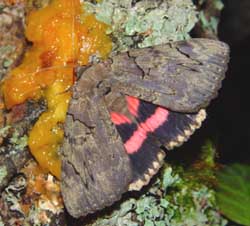
| ** 8832 TONHS/RL Catocala cara;
Darling; 70-85mm.
Fw deep maroon almost purple cast, mixed with
very pale green. Lower half of am & pm lines barely
visible. No distinctive bars or dashes. Two upper
"teeth" on the pm line are thin and long.
The hindwing bands are pink. There is heavy black checking on the
off-white hindwing fringe. The relatively thick black median band of the
hindwing almost reaches the inner margin which is usually heavily
adorned with dark hairs.
Tim Dyson image.
|
Catocala cara, Hannibal, Oswego County, August 28, 1996, Randy Lyttle.
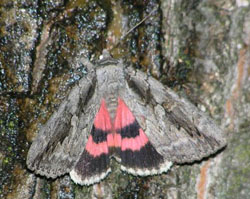
|
** 8834 TONHS/RL amatrix
Sweetheart Underwing; 75-95mm.
Very skittish, frequently hides in caves, under
bridges, under tree bark, etc. by day, resting with head down.
Hw patterning and colouration are similar to that of
Catocala concumbens, but large size
and dark bar running from the basal area to just below apex
distinguishes Catocala amatrix.
|
Catocala amatrix, Hannibal, Oswego County, August 20, 2001, Randy Lyttle.
|
|
|